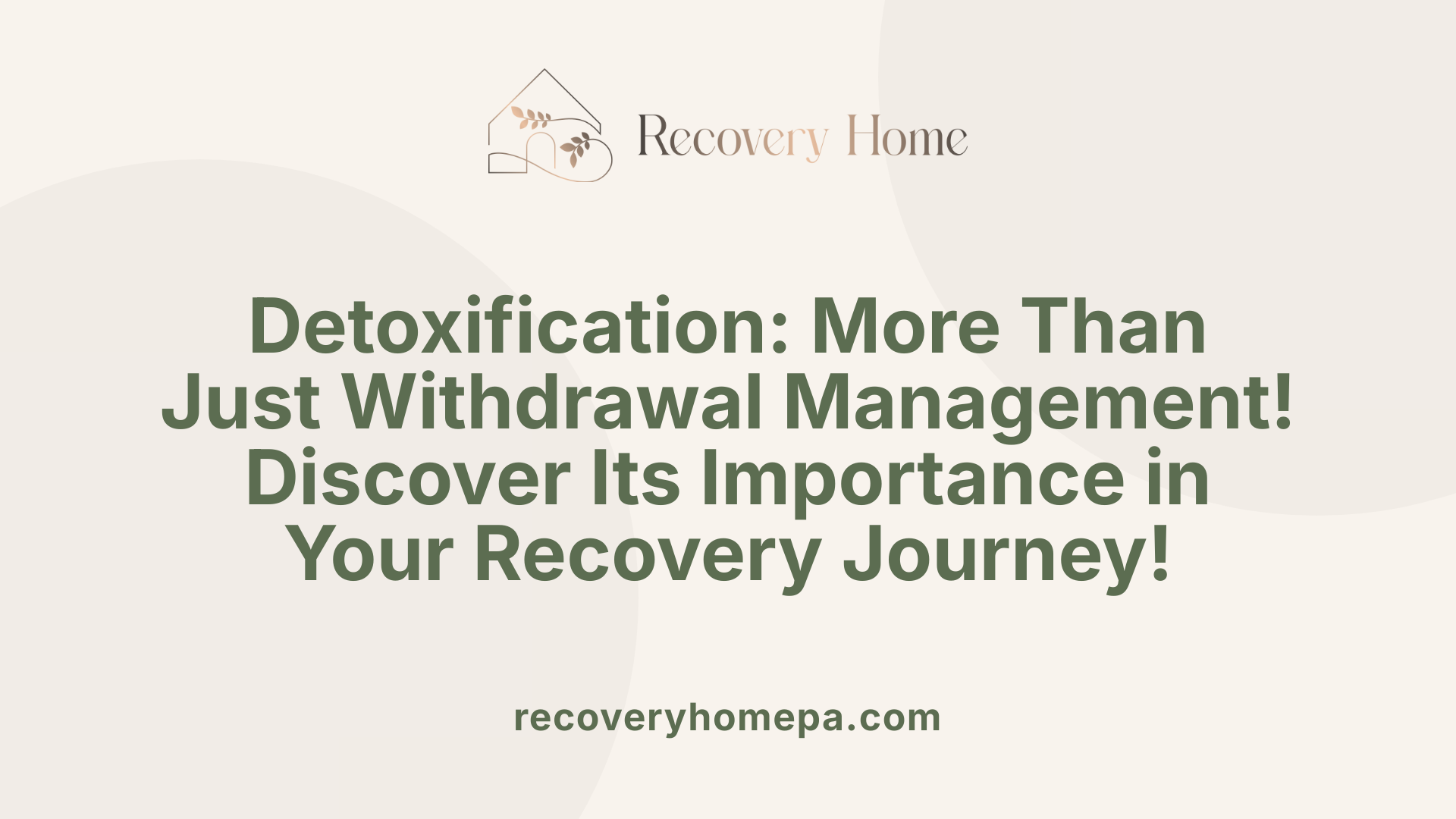How Ambulatory Detox Provides a Safe Alternative to Inpatient Detox
March 6, 2025
Exploring the Safety and Benefits of Ambulatory Detox Over Inpatient Care

Introduction
Detoxification is a critical first step in overcoming substance use disorders. Choosing the right detoxification method can significantly impact the recovery journey. While inpatient detox has been the traditional go-to for comprehensive care, ambulatory detox presents a compelling alternative that merits exploration. This article delves into how ambulatory detox provides a safe, flexible, and effective option for those struggling with mild to moderate withdrawal symptoms, offering a viable alternative for suitable candidates.
Understanding Ambulatory Detox: A New Pathway in Recovery

Definition of Ambulatory Detox
Ambulatory detox, or outpatient detox, is an innovative approach to substance withdrawal where individuals receive medical care without needing to stay overnight in a facility. This outpatient model allows patients to detoxify in their own homes or local treatment centers while maintaining their daily routines, such as work and family responsibilities.
Structure of Ambulatory Detox Programs
Typically, ambulatory detox programs are structured around an initial comprehensive health assessment, followed by regular check-ins and consultations with healthcare providers. These programs are tailored to the individual's needs, often utilizing a combination of medication-assisted treatments (MAT) and non-medication therapies to manage withdrawal symptoms effectively. Sessions often include:
- Initial assessment (1 to 2 hours)
- Follow-up check-ups (15 to 30 minutes each)
- Treatment duration averaging 6.5 days
Patients may receive support from a team of professionals, including physicians, therapists, and peer specialists, ensuring a comprehensive approach to treatment.
Candidates for Ambulatory Detox
Ambulatory detox is generally suitable for individuals exhibiting mild to moderate withdrawal symptoms who have a strong support system at home. Ideal candidates often include:
- Those without significant medical or psychiatric issues
- Individuals displaying a willingness to engage in treatment
- Patients with stable living environments
- Those with robust social support networks to minimize relapse risks
How does ambulatory detox work, and is it effective?
Ambulatory detox is an outpatient service designed to help individuals safely withdraw from mood-altering substances like alcohol while receiving care in various settings such as healthcare facilities or at home. The process is medically supervised and involves thorough evaluations, including a detailed medical history and physical examination. Trained clinicians administer detoxification according to set schedules and defined medical protocols, aiming to ensure a comfortable experience for the patient. The treatment incorporates individual assessments and may involve medication or non-medication methods, with family participation encouraged. Effectiveness can vary based on the individual's circumstances, but regular monitoring and adjustments to the treatment plan help support the transition into ongoing care.
Comparing Inpatient and Outpatient Treatment Models

What is the difference between inpatient and outpatient addiction treatment?
Inpatient addiction treatment requires individuals to live at a rehab facility, offering 24/7 medical and mental health support, which is crucial for those detoxing from severe substance use issues. This type of program typically lasts at least 30 days and is more intensive, designed for individuals needing close supervision.
In contrast, outpatient treatment allows individuals to attend sessions during the day while living at home, providing more flexibility and requiring a commitment that may span over two months. Outpatient programs generally cost less and are less intensive, even though they may last longer in total duration. Successful recovery is often linked to longer treatment times, regardless of whether the approach is inpatient or outpatient.
Advantages and disadvantages of each model
Inpatient Detoxification
| Pros | Cons |
|---|---|
| Constant medical supervision | Higher costs for treatment |
| Structured environment | Potential to lose daily routines |
| Ideal for severe cases | Length of stay can be longer |
Outpatient Detoxification
| Pros | Cons |
|---|---|
| Less expensive than inpatient care | Higher risk of relapse due to accessibility to substances |
| Flexibility to maintain daily activities | Less intensive monitoring of withdrawal symptoms |
| Stronger family and social supports | May miss treatment appointments leading to incomplete detox |
The choice between inpatient and outpatient detox should depend on the severity of the addiction and individual circumstances, including home support and financial considerations.
The Role of Detoxification in Recovery

What is the role of detoxification aside from safely managing withdrawal symptoms?
Detoxification serves as a critical first step in the recovery journey, extending well beyond the mere management of withdrawal symptoms. Primarily, it offers a medically supervised environment that allows individuals to effectively cleanse their bodies of harmful substances. This is particularly vital for substances like alcohol and benzodiazepines, which pose risks of severe complications such as delirium tremens— a potentially fatal condition if not properly managed.
In addition to physical cleansing, detoxification lays the groundwork for ongoing recovery efforts. During this phase, healthcare providers can create tailored treatment plans that not only address the withdrawal process but also incorporate medications to alleviate cravings and ensure sustained sobriety.
Furthermore, detoxification opens doors to psychological support and counseling that tackle the underlying issues contributing to substance dependence. By providing emotional and therapeutic assistance, detoxification helps to prepare individuals for the following phases of recovery, ultimately promoting overall health and wellness.
Medical aspects of detoxification
The medical aspects of detoxification are paramount in ensuring safe and effective treatment. A comprehensive initial assessment evaluates mental and physical health, addiction severity, and withdrawal symptoms, guiding healthcare professionals in establishing a personalized detox plan.
Each individual's plan might involve regular monitoring and the use of medication-assisted treatment (MAT) to mitigate withdrawal symptoms and cravings. Clinicians can administer necessary medications during outpatient visits, ensuring that patients are supported while detoxing. This medically supervised framework is essential in balancing the risks associated with withdrawal while fostering a greater likelihood of transition into long-term recovery.
| Aspect | Outpatient Detox | Inpatient Detox |
|---|---|---|
| Supervision | Regular medical visits with healthcare providers | 24/7 monitoring by addiction specialists |
| Environment | Home or familiar setting, maintains daily routine | Structured inpatient facility, controlled stimuli |
| Support Availability | Family involvement encouraged, community support | Limited external support, relies on facility staff |
| Cost Efficiency | More affordable, no residential fees | Higher due to overnight stays and facility fees |
Detoxification fundamentally acts as a gateway to a more extensive recovery journey, benefitting patients and establishing a solid foundation for sustained sobriety.
Person-Centered Approach: Benefits of Ambulatory Detox

How does the flexibility and person-centered approach of ambulatory detox compare to traditional inpatient detox methods?
Ambulatory detox offers a significant advantage over traditional inpatient detox methods through its flexible and person-centered approach. Patients engaged in outpatient detox are able to maintain their daily activities, such as work and family responsibilities, which can enhance their emotional well-being and provide a stronger support network. This flexibility helps reduce the stress that often accompanies leaving home for treatment.
Additionally, outpatient settings promote an integrative care model. They combine Medication-Assisted Treatment (MAT) with behavioral health support, addressing both medical and psychological needs. This dual approach can lead to better long-term recovery outcomes.
Moreover, ambulatory detox is generally more cost-effective. Patients can experience lower treatment costs and benefit from more favorable insurance coverage compared to inpatient programs. In contrast, inpatient detox remains crucial for individuals with severe addictions, especially those who might face serious withdrawal complications, as it provides constant medical supervision.
Ultimately, the decision between outpatient and inpatient methods should hinge on individual factors including addiction severity, available support systems, and medical history, ensuring a tailored approach to recovery.
Navigating the Risks and Challenges of Ambulatory Detox

Potential challenges in outpatient detox
While outpatient detoxification offers numerous advantages, such as flexibility and cost-effectiveness, it also presents specific challenges. One major risk is the potential for relapse since patients generally have easier access to alcohol and may face triggers in their home environments. The lack of constant supervision leads to concerns about missed appointments, which can result in incomplete detoxification.
Additionally, patients experiencing withdrawal symptoms may occasionally encounter medical emergencies, which can be overlooked without continuous monitoring. Emotional barriers, such as fear or uncertainty about treatment, may also deter individuals from fully engaging in the process.
Strategies to mitigate risks
To effectively address these challenges, several strategies can be implemented. First, ensuring a stable home environment and establishing a strong support network is crucial. Involving family members in the detox process can foster a secure atmosphere conducive to recovery.
Regular follow-ups with healthcare providers during scheduled sessions can help maintain accountability and monitor patient progress. Furthermore, utilizing Medication Assisted Treatment (MAT) can alleviate significant withdrawal symptoms, keeping patients engaged in the detox process. Combining these strategies with comprehensive assessments can enhance the overall effectiveness and safety of ambulatory detox programs.
Integrating Ambulatory Detox into the Broader Treatment Spectrum
Ambulatory Detox Role in Broader Treatment Systems
Ambulatory detox serves as a vital component in the continuum of care for individuals battling substance use disorders. This outpatient approach allows clients to undergo withdrawal in a supportive home environment while receiving regular medical supervision. By facilitating a balance between treatment and daily life, ambulatory detox enhances emotional support from families, greatly benefiting long-term recovery outcomes.
Candidates for ambulatory detox typically possess mild to moderate withdrawal symptoms and can maintain their responsibilities, making this model particularly effective for those with a stable home life. Studies indicate that when supported by ongoing therapy and recovery programs, outpatient detox outcomes are comparable to inpatient care, validating its role as a cost-effective first-line treatment option.
Partnerships and Models Enhancing Ambulatory Detox
Innovative partnerships, such as the collaboration between CBC and Samaritan Daytop Village, have led to refined ambulatory detox models utilizing the Substance Use Therapy and Recovery Treatment (START™) framework. This integrated approach ensures comprehensive assessments and tailored detox plans, optimizing care delivery.
Moreover, initiatives like the Virtual Home-Based Detox program exemplify how technology enhances outpatient services, allowing patients to detox in familiar surroundings under medical supervision. Such advancements underscore the importance of integrating ambulatory detox within traditional treatment frameworks, fostering a more adaptable and supportive care environment for individuals seeking recovery.
Conclusion
Ambulatory detox presents an innovative and structured approach to managing substance withdrawal in an outpatient setting, offering a balance between safety, effectiveness, and personal freedom. While it stands as a suitable alternative to inpatient detox for those with mild to moderate withdrawal symptoms and a supportive environment, careful consideration of individual patient needs and risk factors is crucial. The continued development and implementation of ambulatory detoxation models like the CBC START™ represent an essential step towards creating more accessible and person-centered treatment options in the battle against substance addiction.
References
- An Overview of Outpatient and Inpatient Detoxification - PMC
- CBC Ambulatory Detox - Coordinated Behavioral Care
- Ambulatory Detoxification Explained - Providence Treatment
- Ambulatory Detox vs. Inpatient Detox: Which One Is Right for You?
- Understanding Ambulatory Detoxification: Is It Right for You?
- What Is Ambulatory Detox? - Athens Area Commencement Center
- Outpatient Detox in Northridge, CA | Miracles in Action
- Inpatient Vs. Outpatient Rehab - Addiction Center
- 2 Settings, Levels of Care, and Patient Placement - NCBI
Frequently Asked Questions


